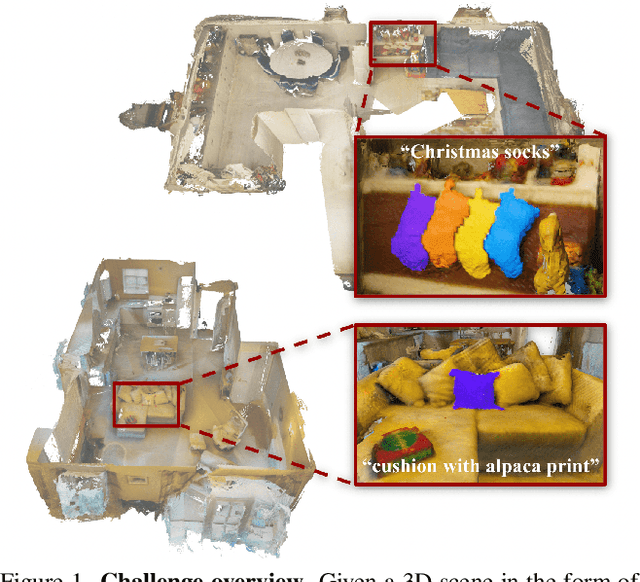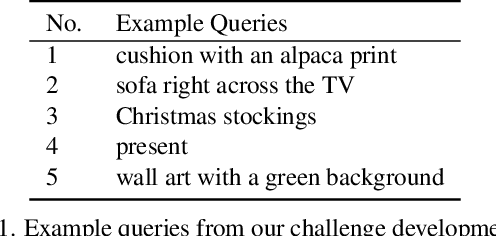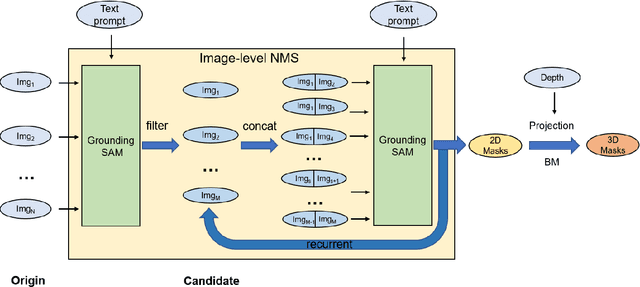Or Litany
FRIDU: Functional Map Refinement with Guided Image Diffusion
Jun 17, 2025Abstract:We propose a novel approach for refining a given correspondence map between two shapes. A correspondence map represented as a functional map, namely a change of basis matrix, can be additionally treated as a 2D image. With this perspective, we train an image diffusion model directly in the space of functional maps, enabling it to generate accurate maps conditioned on an inaccurate initial map. The training is done purely in the functional space, and thus is highly efficient. At inference time, we use the pointwise map corresponding to the current functional map as guidance during the diffusion process. The guidance can additionally encourage different functional map objectives, such as orthogonality and commutativity with the Laplace-Beltrami operator. We show that our approach is competitive with state-of-the-art methods of map refinement and that guided diffusion models provide a promising pathway to functional map processing.
GAS-NeRF: Geometry-Aware Stylization of Dynamic Radiance Fields
Mar 11, 2025Abstract:Current 3D stylization techniques primarily focus on static scenes, while our world is inherently dynamic, filled with moving objects and changing environments. Existing style transfer methods primarily target appearance -- such as color and texture transformation -- but often neglect the geometric characteristics of the style image, which are crucial for achieving a complete and coherent stylization effect. To overcome these shortcomings, we propose GAS-NeRF, a novel approach for joint appearance and geometry stylization in dynamic Radiance Fields. Our method leverages depth maps to extract and transfer geometric details into the radiance field, followed by appearance transfer. Experimental results on synthetic and real-world datasets demonstrate that our approach significantly enhances the stylization quality while maintaining temporal coherence in dynamic scenes.
ZDySS -- Zero-Shot Dynamic Scene Stylization using Gaussian Splatting
Jan 07, 2025



Abstract:Stylizing a dynamic scene based on an exemplar image is critical for various real-world applications, including gaming, filmmaking, and augmented and virtual reality. However, achieving consistent stylization across both spatial and temporal dimensions remains a significant challenge. Most existing methods are designed for static scenes and often require an optimization process for each style image, limiting their adaptability. We introduce ZDySS, a zero-shot stylization framework for dynamic scenes, allowing our model to generalize to previously unseen style images at inference. Our approach employs Gaussian splatting for scene representation, linking each Gaussian to a learned feature vector that renders a feature map for any given view and timestamp. By applying style transfer on the learned feature vectors instead of the rendered feature map, we enhance spatio-temporal consistency across frames. Our method demonstrates superior performance and coherence over state-of-the-art baselines in tests on real-world dynamic scenes, making it a robust solution for practical applications.
ReHub: Linear Complexity Graph Transformers with Adaptive Hub-Spoke Reassignment
Dec 02, 2024Abstract:We present ReHub, a novel graph transformer architecture that achieves linear complexity through an efficient reassignment technique between nodes and virtual nodes. Graph transformers have become increasingly important in graph learning for their ability to utilize long-range node communication explicitly, addressing limitations such as oversmoothing and oversquashing found in message-passing graph networks. However, their dense attention mechanism scales quadratically with the number of nodes, limiting their applicability to large-scale graphs. ReHub draws inspiration from the airline industry's hub-and-spoke model, where flights are assigned to optimize operational efficiency. In our approach, graph nodes (spokes) are dynamically reassigned to a fixed number of virtual nodes (hubs) at each model layer. Recent work, Neural Atoms (Li et al., 2024), has demonstrated impressive and consistent improvements over GNN baselines by utilizing such virtual nodes; their findings suggest that the number of hubs strongly influences performance. However, increasing the number of hubs typically raises complexity, requiring a trade-off to maintain linear complexity. Our key insight is that each node only needs to interact with a small subset of hubs to achieve linear complexity, even when the total number of hubs is large. To leverage all hubs without incurring additional computational costs, we propose a simple yet effective adaptive reassignment technique based on hub-hub similarity scores, eliminating the need for expensive node-hub computations. Our experiments on LRGB indicate a consistent improvement in results over the base method, Neural Atoms, while maintaining a linear complexity. Remarkably, our sparse model achieves performance on par with its non-sparse counterpart. Furthermore, ReHub outperforms competitive baselines and consistently ranks among top performers across various benchmarks.
A Lesson in Splats: Teacher-Guided Diffusion for 3D Gaussian Splats Generation with 2D Supervision
Dec 01, 2024Abstract:We introduce a diffusion model for Gaussian Splats, SplatDiffusion, to enable generation of three-dimensional structures from single images, addressing the ill-posed nature of lifting 2D inputs to 3D. Existing methods rely on deterministic, feed-forward predictions, which limit their ability to handle the inherent ambiguity of 3D inference from 2D data. Diffusion models have recently shown promise as powerful generative models for 3D data, including Gaussian splats; however, standard diffusion frameworks typically require the target signal and denoised signal to be in the same modality, which is challenging given the scarcity of 3D data. To overcome this, we propose a novel training strategy that decouples the denoised modality from the supervision modality. By using a deterministic model as a noisy teacher to create the noised signal and transitioning from single-step to multi-step denoising supervised by an image rendering loss, our approach significantly enhances performance compared to the deterministic teacher. Additionally, our method is flexible, as it can learn from various 3D Gaussian Splat (3DGS) teachers with minimal adaptation; we demonstrate this by surpassing the performance of two different deterministic models as teachers, highlighting the potential generalizability of our framework. Our approach further incorporates a guidance mechanism to aggregate information from multiple views, enhancing reconstruction quality when more than one view is available. Experimental results on object-level and scene-level datasets demonstrate the effectiveness of our framework.
Epi-NAF: Enhancing Neural Attenuation Fields for Limited-Angle CT with Epipolar Consistency Conditions
Nov 09, 2024



Abstract:Neural field methods, initially successful in the inverse rendering domain, have recently been extended to CT reconstruction, marking a paradigm shift from traditional techniques. While these approaches deliver state-of-the-art results in sparse-view CT reconstruction, they struggle in limited-angle settings, where input projections are captured over a restricted angle range. We present a novel loss term based on consistency conditions between corresponding epipolar lines in X-ray projection images, aimed at regularizing neural attenuation field optimization. By enforcing these consistency conditions, our approach, Epi-NAF, propagates supervision from input views within the limited-angle range to predicted projections over the full cone-beam CT range. This loss results in both qualitative and quantitative improvements in reconstruction compared to baseline methods.
OmniRe: Omni Urban Scene Reconstruction
Aug 29, 2024Abstract:We introduce OmniRe, a holistic approach for efficiently reconstructing high-fidelity dynamic urban scenes from on-device logs. Recent methods for modeling driving sequences using neural radiance fields or Gaussian Splatting have demonstrated the potential of reconstructing challenging dynamic scenes, but often overlook pedestrians and other non-vehicle dynamic actors, hindering a complete pipeline for dynamic urban scene reconstruction. To that end, we propose a comprehensive 3DGS framework for driving scenes, named OmniRe, that allows for accurate, full-length reconstruction of diverse dynamic objects in a driving log. OmniRe builds dynamic neural scene graphs based on Gaussian representations and constructs multiple local canonical spaces that model various dynamic actors, including vehicles, pedestrians, and cyclists, among many others. This capability is unmatched by existing methods. OmniRe allows us to holistically reconstruct different objects present in the scene, subsequently enabling the simulation of reconstructed scenarios with all actors participating in real-time (~60Hz). Extensive evaluations on the Waymo dataset show that our approach outperforms prior state-of-the-art methods quantitatively and qualitatively by a large margin. We believe our work fills a critical gap in driving reconstruction.
Zero-to-Hero: Enhancing Zero-Shot Novel View Synthesis via Attention Map Filtering
May 29, 2024Abstract:Generating realistic images from arbitrary views based on a single source image remains a significant challenge in computer vision, with broad applications ranging from e-commerce to immersive virtual experiences. Recent advancements in diffusion models, particularly the Zero-1-to-3 model, have been widely adopted for generating plausible views, videos, and 3D models. However, these models still struggle with inconsistencies and implausibility in new views generation, especially for challenging changes in viewpoint. In this work, we propose Zero-to-Hero, a novel test-time approach that enhances view synthesis by manipulating attention maps during the denoising process of Zero-1-to-3. By drawing an analogy between the denoising process and stochastic gradient descent (SGD), we implement a filtering mechanism that aggregates attention maps, enhancing generation reliability and authenticity. This process improves geometric consistency without requiring retraining or significant computational resources. Additionally, we modify the self-attention mechanism to integrate information from the source view, reducing shape distortions. These processes are further supported by a specialized sampling schedule. Experimental results demonstrate substantial improvements in fidelity and consistency, validated on a diverse set of out-of-distribution objects.
The NeRFect Match: Exploring NeRF Features for Visual Localization
Mar 14, 2024



Abstract:In this work, we propose the use of Neural Radiance Fields (NeRF) as a scene representation for visual localization. Recently, NeRF has been employed to enhance pose regression and scene coordinate regression models by augmenting the training database, providing auxiliary supervision through rendered images, or serving as an iterative refinement module. We extend its recognized advantages -- its ability to provide a compact scene representation with realistic appearances and accurate geometry -- by exploring the potential of NeRF's internal features in establishing precise 2D-3D matches for localization. To this end, we conduct a comprehensive examination of NeRF's implicit knowledge, acquired through view synthesis, for matching under various conditions. This includes exploring different matching network architectures, extracting encoder features at multiple layers, and varying training configurations. Significantly, we introduce NeRFMatch, an advanced 2D-3D matching function that capitalizes on the internal knowledge of NeRF learned via view synthesis. Our evaluation of NeRFMatch on standard localization benchmarks, within a structure-based pipeline, sets a new state-of-the-art for localization performance on Cambridge Landmarks.
OpenSUN3D: 1st Workshop Challenge on Open-Vocabulary 3D Scene Understanding
Feb 23, 2024



Abstract:This report provides an overview of the challenge hosted at the OpenSUN3D Workshop on Open-Vocabulary 3D Scene Understanding held in conjunction with ICCV 2023. The goal of this workshop series is to provide a platform for exploration and discussion of open-vocabulary 3D scene understanding tasks, including but not limited to segmentation, detection and mapping. We provide an overview of the challenge hosted at the workshop, present the challenge dataset, the evaluation methodology, and brief descriptions of the winning methods. For additional details, please see https://opensun3d.github.io/index_iccv23.html.
 Add to Chrome
Add to Chrome Add to Firefox
Add to Firefox Add to Edge
Add to Edge